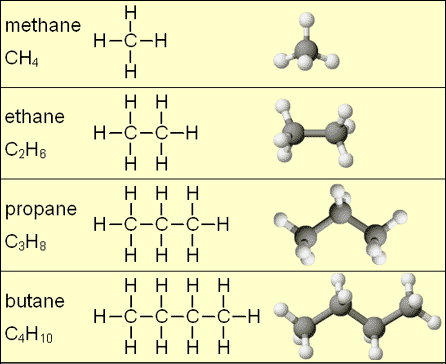alkanes

The four simplest alkanes.
Alkanes, also known as paraffins, are the simplest of organic compounds. They are saturated hydrocarbons that form an homologous series with the general formula CnH2n+2. The first few in the series are methane, ethane, propane, and butane; from pentane on they are named after the number of carbon atoms in the molecule. Lower members in the series are gases; from pentane (C5H12) to heptadecane (C17H36) they are liquids; higher members are waxy solids.
Alkanes with four or more carbon atoms have several isomers, the straight-chain isomers being called normal alkanes (n-alkanes). Branched alkanes are named as derivatives of the longest straight chain in the molecule.
Alkanes are present in natural gas and petroleum.; they may be synthesized by hydrogenation of alkenes or from carbon monoxide and hydrogen. The higher members can be cracked to form smaller alkanes and alkenes.
Alkanes are soluble in most organic solvents, but not in water. The lower alkanes are less reactive than the higher ones. Typical reactions include combustion in air, decomposition and rearrangement on heating, isomerization and condensation with alkenes (with acid catalyst), nitration, sulfonation, and halogenation by fluorine, chlorine, and bromine (with heat and light).
Alkanes are converted into other compounds by replacing a hydrogen with other functional groups. The most important substitutions for biochemistry are –OH (alcohol), –CHO (aldehyde), –COO –R – (ester, R=alkyl group), –COOH (carboxylic acid), –PO4 (organic phosphate), and –NH2 (amine).
Alkyl group
The monovalent radicals CnH2n+2 derived from alkanes by loss of one hydrogen atom are called alkyl groups (methyl, ethyl, etc.). Alkyl groups are abbreviated as 'R' in structural formulas.
Alkylation
Alkylation is the introduction of an alkyl group into a compound by substitution or addition, usually done by reacting the compound with an alkene or alkyl halide (see Friedel-Crafts reaction.) Specifically in petroleum refining, alkylation refers to the thermal or catalytic process in which branched alkanes are reacted with alkenes to yield highly branched products of high octane rating.
Alkyl halide
An alkyl halide is an organic compound consisting of an alkyl group bonded to a halogen atom; polyhalogen derivatives of alkanes are similar. They are prepared by direct halogenation of alkanes (except for the iodides), addition of hydrogen halides to alkenes, or halogenation of alcohols by hydrogen halides, phosphorus (III) halides, etc. Alkyl halides are used as solvents and as intermediates in chemical manufacture. The halogen atom is readily replaced by other nucleophiles such as hydroxide or cyanide. Elimination of hydrogen halides (base-catalyzed) yields alkenes.
Haloalkane
A haloalkane is an organic chemical compound consisting of an alkane in which one or more hydrogen atoms have been substituted by a halogen element. Haloalkanes, also known as alkyl halides, are used as solvents and in organic synthesis. Examples include iodomethane (methyl iodide, CH3I), dibromomethane (methylene bromide, CH2Br2), trichloromethane (CHCl3, chloroform), and tetrachloromethane (carbon tetrachloride, CCl4). Haloalkanes are made by halogenating an alcohol or by the direct reaction between a halogen and an alkane in ultraviolet light. Chlorofluorocarbons (CFCs) are haloalkanes.
Cracking
Cracking is a form of thermal decomposition, which breaks long chain hydrocarbons, many of which are not very useful, into shorter molecules by heating them. Many of the substances with longer molecules produced from the fractional distillation of crude oil are cracked; for example, naphtha is cracked to produce gasoline. Cracking also produces extra alkenes, which are needed for making plastics.
In industrial cracking, vaporized hydrocarbons are passed over powdered aluminum oxide catalyst at a temperature of 400°–700°C. Since any of the C–C bonds in a molecule can break, the result is a mixture of products, although the conditions for the reaction are chosen to favor some products over others.


